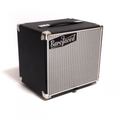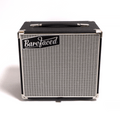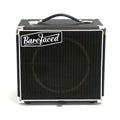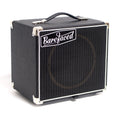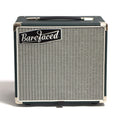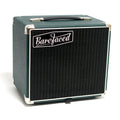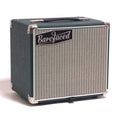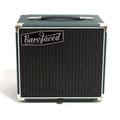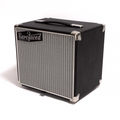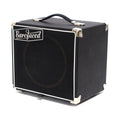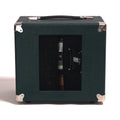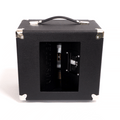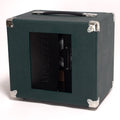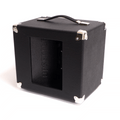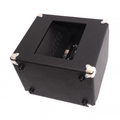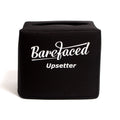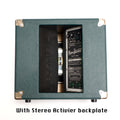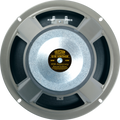Upsetter 110 / 112N
Regular price
£349.00
£449.00
It’s a single 10” driver with a bigger warmer tone than a closed-back 1x12” but the room-filling clarity and air of an open-backed cab. It’s so light it weighs less than a guitar in a case and so small it’s almost airline hand luggage!
The standard speaker is a Celestion G10 Vintage and you can choose from silver or black cloth grills and British Raging Green or Black In Black tolex. And if the G10 Vintage isn’t the tone you want then you can choose to have literally any Celestion 10” guitar speaker in the Upsetter 110.
And if you'd like a bigger 1x10" cab, either to look good under a larger amp head or for the even bigger tone made possible by a larger enclosure, you can instead choose a custom Reformer 110W.
We also have an unique option of fitting a custom-made Upsetter cab with one of Celestion's neo 12" drivers - yes, a 12" will (only just!) fit into this tiny cab. If you'd like to choose this customisation then you can select it in the "Impedance and Speaker Configuration" drop-down. You'll need to also select your neo 12" driver and add that to the cart - there's a choice of the Neo Creamback, Neo V-Type and Neo 250 Copperback.
Specifications
| Stock - G10 Vintage | Custom - Min/Alt | |
| Dimensions (H x W x D) |
33.5cm x 38cm x 28cm 14" x 15" x 11" |
|
| Weight | 6 kg / 13 lbs | 5 kg / 11 lbs (Ten30) |
| Driver | Celestion G10 Vintage | Four other Celestion tens to choose from |
| Enclosure design | AVD | |
| RMS power handling | 60W RMS | 30W RMS (Greenback/Ten30) |
| Nominal Impedance | 8 ohm | 16 ohm |
Features
- Innovative internal design - Barefaced AVD enclosure for superior audibility, efficiency and power handling
- Low-cut filter toggle switch
- Choose from the entire range of Celestion 10" speakers. Celestion G10 Vintage fitted as standard.*
- Either a black or silver cloth grill with white piping.
- British Raging Green or Black in Black tolex.
- Single top strap handle
- Rubber feet on base
- Dual combi 1/4” + speakon sockets
*Additional customisation fee applies. See below.
Questions
Traditional guitar loudspeaker designs.
There are basically two sorts - closed-back and open-backed. Open-backed because they were combos and needed to keep the valves cool and accessible for servicing, closed-back and sealed because that’s how most speakers were made in the 1960s.
How does that affect using them?
The closed-back cabs have narrowing dispersion as frequency increases (a hi-fi speaker uses smaller speakers for higher frequencies to reduce this problem). The open-backed cabs fire sound out of the back as well as the front, so although the dispersion narrows from both front and back in much the same way as the closed-back cab, the sound coming out of the back helps fill the room with mids and highs - but that sound out of the back cancels out most of the lows (due to the inverted phase as the back of the speaker pulls when the front pushes and vice versa). In other words, open-back cabs are easier to hear around the room but the lows are thinner.
How is the Upsetter 110 different?
From the front it behaves much like a closed or open-backed cab. But the mids and highs coming out of the AVD at the back are amplified and dispersed around the room whilst the lows are inverted to match the lows from the front, giving lots more bottom. Basically you get twice the output of a closed back cab with an identical speaker AND even better dispersion and audibility (and far far greater output) than an open-backed cab
What is AVD?
You see it when you look at the back of the cab - it’s the Augmented Vent Diffractor. It’s a unique patended technology that we started developing back in 2013. At low frequencies it acts as a tuned vent or Helmholtz resonator, improving efficiency, power handling and output. At mid and high frequencies it acts to diffract, disperse and couple the sound with the room for improved audibility and output especially in rooms with poor acoustics.
What is the Lo Cut filter for?
The increased low frequency output from the AVD may be too much for some guitarists’ tastes - so you can flick this switch and remove lows at the cab. Doing so not only changes the bass response but also increases the power handling of the cab, lowers the distortion due to motor excursion and reduces the load on your amp’s output stage. This can give you two different sweet-spots of optimum speaker overdrive or break-up and two different sweet-spots of power valve overdrive. If your sound is perfect in rehearsal but too dirty at a louder gig then engaging the Lo Cut filer will clean it up.
Customer feedback
12/10/25 - Upsetter 110 (G10 Gold) - Czechia
Dear Alex,
I've been using the Upsetter 110 for a while now so I can finally give some user review. Overall I am pretty happy with the sound. I especially like:
- How much presence there is (last 2 gigs with just drums and bass I didn't even have to mic the cabinet)
- It takes the overdrive from my H&K Tubemeister surprisingly well
- Clean rhythm parts where I strum quick "stacatto" chords have a very pleasant attack to them, almost as if the tone was little bit compressed
There is only one negative point, however. Some tones (mostly a4-c5) tend to resonate louder than other tones if I stand too close to the cabinet. I suspect that might be due to me playing a hollow-body guitar. But as I was saying, all in all a very good cabinet. Hope this helps.
Adam
11/11/25 - Upsetter 110 - UK
A friend (Lewie Bonner) used a Barefaced 1×10 cab on a gig where I was doing sound. It absolutely blew my mind.
The little 1×10 instantly became my favourite speaker. The Celestion G10 sounds phenomenal, the cab weighs next to nothing, and it just feels right. Finally, my rig started shrinking.
A few gigs later, I realised I didn’t even need the Fryette anymore. The small cab had solved the beaming problem. Sound engineers were happy, and as long as I had a monitor, I could hear myself perfectly.
It really does sound incredible and the cab is the main reason it does.
Dan
28/05/25 - Upsetter 112N (Neo Copperback) - NZ
- I really like the cab, the AVD works as advertised giving semi omni dispersion up into the low mids, making the cab sound much bigger than it is and going deeper than you would expect for the size. It's crazy light and rigid with the right amount of cab resonance for guitar.
- I absolutely loathe the Neo Copperback speaker. It's entirely my fault, I got exactly what I ordered. I really wanted to like it. I tried very hard to like it, spending several days trying to get a sound I liked dialled in without success. I tried it against about 8 different guitar speakers (V30s, weber grey wolf, weber silver wolf, tone tubby alnico red, JBL K140, greenbacks, Eminence guv'nor) and I found everything else far preferable. I would suggest that the Copperback is so unlike other guitar speakers, that it would probably be useful to encourage anyone who is thinking of getting one to try one is person if possible, or at least listen carefully to some of the comparison videos on youtube. This is doubly true for anyone having it shipped to the opposite side of the planet.
20/05/25 - Upsetter 110 (G10 Creamback) - USA
I got the cab- I LOVE IT!
Thanks to everyone
Dan
06/05/25 - Upsetter - UK
The Upsetter is in my opinion the best guitar cab ever made.
Dan



















